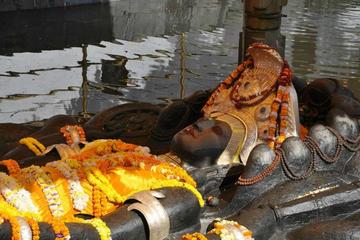Budhanilkantha
TIME : 2016/2/22 12:06:45

Budhanilkantha
The five-meter-long and thus biggest stone statue in Nepal, Budhanilkantha, portrays a sleeping Vishnu, floating like a gigantic astronaut on a bed of snakes in the middle of a big pool of water depicting the cosmic ocean. The incredibly well preserved carving is made out of black stone and is thought to be 1500 years old. Located in the village of the same name, the holy site is a popular spot for Hindus to practice puja, a prayer ritual to worship the gods. The daily ceremony entails priests – they are the only ones allowed to approach Vishnu’s divine head - washing the face and the feet of the sculpture with water and afterwards, applying a mixture of ghee, milk, yoghurt, honey and sugar on the same spots.
Later, since only Hindus are allowed to get close the statue, believers worship at its feet and leave offerings of food and flower petals. All other visitors have to be content with viewing the resting Vishnu from the sidelines. The only person who was never allowed to visit was the king back when Nepal was still a monarchy. Some say the reason is a curse, which would instantly kill the king if he saw the statue, while others claim that the monarch was the reincarnation of Vishnu and therefore, wasn’t allowed to see his own image.
By the way, the name Budhanilkantha has nothing to do with Buddha, but literally means “blue throat disguised by mud”. The peculiar name refers to two legends attached to the statue, one of them saying that a farmer found the long lost statue in the mud when working his field with a plough and the other saying that Vishnu sacrificed himself by drinking the poison of the cosmic ocean, which then turned his throat blue.
Practical Info
Budhanilkantha can be found about 15 kilometers north of Kathmandu. It’s easiest to get there either by taxi, or by taking one of the many busses and minibusses making the journey. When you get out, you can find the statue about 100 meters to the east of the Budhanilkantha stop.
